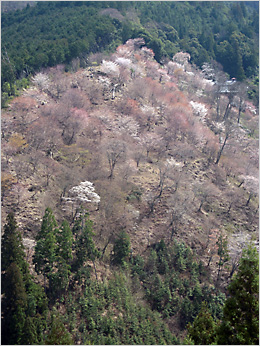Utsuroi

Cherry blossoms are among the most beloved of flowers in Japan. Cherry blossoms begin to bloom at the southern end of Japan and the blooming moves northward gradually along the Japanese archipelago. This process is called "sakurazensen (cherry blossom front)" and this phrase is also used in weather forecasting for heralding the start of spring. When cherry blossoms are in full bloom, it is high time to have ohanami (cherry-blossom-viewing) parties under the cherry trees. Having ohanami parties with friends, family or colleagues is a very popular seasonal tradition in Japan. As well as viewing cherry blossoms in full bloom, Japanese people love to see the showers of cherry blossoms. Cherry petals fall like snowflakes and this is called "sakurafubuki."
The cherry blossom season is short and the petals fall after about a week. This transience of life (utsuroi) expresses mujō (impermanence). Everything in the world is all transient in both figure and essence, and any entity cannot keep its form, even for a moment. It is said that the Japanese view of nature is based on impermanence, one of the essential doctrines in Buddhism. When a flower falls and a life ends, Japanese people find utsuroi (transience) there, and love and cherish precious life because it is short, transient and impermanent.
Japanese not only love the cherry blossom season, but also respectfully praise the beauty of nature throughout the four seasons. A saijiki (year time chronicle) which includes seasonal traditions, animals, plants, lifestyles and annual events is a list of kigo (seasonal terms) used in haiku. Haiku is a fixed verse form of seventeen syllables arranged in a five-seven-five pattern to express the beauty of nature and emotions caused by it. Today's style of haiku was developed in the Edo period. In principle, a haiku must have a "kigo." Kigo are words that effectively express feelings about the season. Utsuroi of the four seasons are emotionally expressed in haiku as well.
Matsuo Bashō (1644-1694) who is recognized as the most outstanding poet in the history of Japanese modern literature traveled throughout Japan and wrote a lot of haiku. Bashō expressed his thoughts in seventeen syllables through the utsuroi of seasons.
Toshi doshi ya / sakura o koyasu / hana no chiri
(Cherry blossoms bloom, the petals fall, and then the dust of the petals enriches the soil around the cherry trees. Cherry blossoms can bloom beautifully again. Life continues year by year. (March 23, 1691. Translation of the original haiku)
As in this haiku, the lives in our existence are linked with each other. In this linkage, one passes away and another is born. The Japanese people face nature and cherish their lives through the transient seasons.
We are all born and die. For modern people who have fewer opportunities to conserve, commune and know nature, to think of the utsuroi of seasons is to sense again the preciousness of human co-existence with nature.
(Rieko Tanimoto)










